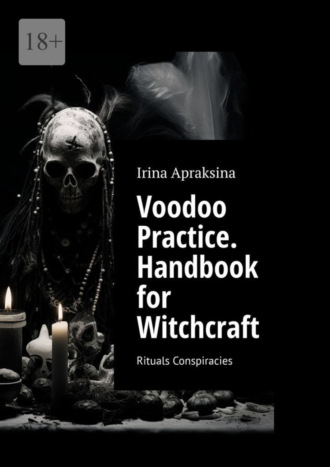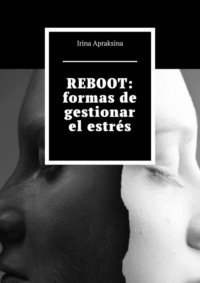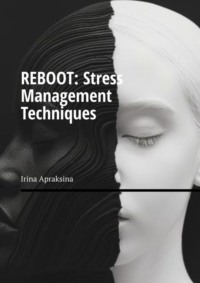
Полная версия
Voodoo Practice. Handbook for Witchcraft. Rituals Conspiracies

Voodoo Practice. Handbook for Witchcraft
Rituals Conspiracies
Emma Кoh
© Emma Кoh, 2025
ISBN 978-5-0062-4717-8
Created with Ridero smart publishing system
content
Chapter 1. Introduction. A short history of Voodoo
Chapter 2. Signs and Symbols: Image and meaning
Chapter 3. Voodoo Magic Tools
Chapter 4. The Magical symbols of VEVEY and Grigri
Chapter 5. Amulets and Talismans:
creation, meaning, influences
Chapter 6. The Voodoo doll and the rituals with it
Chapter 7. Various magical tools from the animal and plant world: rite, rituals and conspiracies
Chapter 8. Magic rituals, rituals, conspiracies: money, success, finance
Chapter 9. Magical rituals, rituals, prayers, spells for love, family and the birth of children
Chapter 10. Magic candles and Incense: colors, combination, composition, Voodoo effects
Chapter 11. Magic stones and working with them
Chapter 12. Communication with the Souls of the deceased: rituals, conspiracies, prayers
Chapter 1. Introduction: briefly about the history of Voodoo
As an introduction and before you move on to practical knowledge of Voodoo magic, I want to warn you against unforgivable mistakes and underestimating the possibilities of Voodoo magic. This means that all your actions must be imbued with deep respect for the Gods and Spirits of Voodoo. You should definitely say words of gratitude after every ritual, rites, and any action you perform within the framework of Voodoo magic. And of course, you must be able to put up magical defenses against unwanted influences from Spirits or Gods that you cannot control.
Putting yourself under protection during Voodoo rituals is important to ensure your physical and energy security. Here are a few steps you can take to protect yourself during magical practice. The first is to cleanse and protect the astral field. Before starting any ritual, be sure to cleanse your astral field with meditation, visualization or aromatic oils such as lavender, St. John’s wort, chamomile or santal. This will help to remove negative energies and create a protective barrier. Use protective amulets and talismans when conducting magical practices. Protective amulets or talismans can be charged with magical power and serve as symbols of protection from negative energies. Include protection rituals in your magical practice. For example, you can place white candles on the altar, recite a prayer of protection, or use symbols such as a pentagram to create a protective circle around yourself, which is created before the start of the ritual ceremony. walk around the perimeter of your workspace and visualize how the energy wall rises, protecting you from negative influences. Say a prayer or a spell, addressing the spirits or loa, ask for protection and guidance during the ritual. Be sure to finish any ritual or rite correctly. Say goodbye to the spirits and Loa (Voodoo gods), thank them for their help and close the magic circle to break the connection with the magical forces. After completing the ritual, do a short meditation or visualization to make sure that you are completely cleansed and protected from negative influences. It is also very important to observe ethical standards in your magical practice. After the ritual, pay attention to your physical and emotional standing. Take care of yourself to restore energy and harmony. To effectively protect yourself in magical practice, learn and improve in this direction. Knowledge and experience will help you better understand how to work with energy and strength. Remember that protection is an important part of magical practice, and it must be integrated into your Voodoo rituals to ensure your safety and the success of your magical efforts. And now that you already understand how to properly put up a defense, you can proceed directly to practice. To put up the right protection, it is necessary to deeply understand the meaning of the magic circle in Voodoo Magic. Its great importance allows us to dwell on this concept in a little more detail, for a deeper understanding of working with it. The magic circle is an important element of magical practices in many magical systems, including voodoo magic. A magic circle is a symbolic or physical space, usually surrounded by a barrier, which serves to distinguish magical work from the outside world and to protect against negative The main function of the magic circle in voodoo magic is to create a protective barrier around the practitioner and the magical work. The circle serves as a filter that allows only positive and desirable energies to enter the magical space, and repels negative influences and unwanted spirits. A magic circle can also serve to concentrate and enhance the magical energies within it. It creates a kind of “energy reflection” that can enhance the effectiveness of a ritual or magical practice. The circle defines the boundaries of the magical space, separating it from the world of reality. This helps the practitioner to focus on the magical work and avoid distractions, energies and interference. So, what does a MAGIC CIRCLE in VOODOO mean? Creating a magic circle in voodoo magic usually involves the following steps: The first is choosing a place suitable for performing a ritual or magical practice. This place should be clean and cozy. Next, clean the place of negative energies, using, for example, smoking white salvia or any aromatic oils. Then draw a symbolic circle on the ground or on the floor.
It can be a circle, a triangle, a pentagram, or another symbol associated with your magical practice. Raise the energy and charge the circle with prayer, meditation or other magical methods. Imagine how the energy barrier is recreated around you.
After the end of the magical practice, it is necessary to close the magic circle in order to break the connection with the magical world and return to everyday reality. This can be done as follows: If you have interacted with spirits or gods, thank them for participating in the ritual and ask them to leave. Disperse the energy that you charged into the circle. Imagine how the barrier slowly disappears and the energy returns to nature. Symbolically close the circle, for example, by noticing how it disappears in reverse order, returning to the ground. Thank the forces and the spiritual space for their support and help in the ritual. Closing the magic circle helps to complete the magical work and return to everyday life, as well as prevent the influence of unwanted energies and entities after the completion of the ritual. Let’s take a closer look at what Wood Magic is and where this concept came from. Voodoo magic is a complex of religious and magical practices that have roots in the African diaspora, especially among African slaves brought to the New World, in particular to Haiti and Louisiana. Its history and origins are complex and linked to different aspects of African, Caribbean, and American culture. The main roots of Voodoo Magic are associated with the religious and magical practices of African peoples, especially from the regions now known as West and Central Africa. Among these peoples there were various beliefs, rituals and rituals, which were subsequently mixed with other cultural influences. During the colonial era, African slaves were brought to the Caribbean and the Southern United States, bringing their traditions and religious practices. These African elements mixed with Christian and other cultural influences, including Native American and French. In Haiti, a successful slave revolution took place in the late 18th and early 19th centuries, which led to the creation of an independent State of Haiti. During this revolution, the religious and magical practices of African slaves became a strong symbol of resistance and unity. This important event contributed to the spread of Voodoo Magic. Louisiana, which also had slaves, formed its own version of Voodoo Magic, known as “Louisiana Voodoo.” This version also includes elements of the Native American and Catholic traditions. The origin and history of Voodoo Magic are linked to a variety of cultural and historical factors. Let’s take a closer look at some of them, as well as provide examples of Voodoo Magic practices: The first thing to focus on is certainly the African roots of Voodoo magic, which has roots in the religious and magical practices of African peoples such as the Yaoruba, Dahome, Fon and others. These peoples had their own gods, rituals and magical rituals. For example, the Yoruba worshipped orisha (gods) and practiced rituals to attract their attention and gain favor. The colonial legacy, which also had a great influence on the development of Voodoo magic. During the period of slavery, African slaves were brought to colonial territories, where their religious and magical practices clashed with Christianity and other cultural influences. This led to the mixing and syncretism of beliefs. For example, the Orishas of African religions became associated with Christian saints, and such associations became part of Voodoo Magic. Voodoo practices are rooted in African religious traditions, including belief in spirits, ancestors, and magical rituals. Voodoo also includes elements of priesthood and cult worship. Resettlement to America: During the slave trade era, many African slaves were brought to America, where they introduced their religious and magical practices, including voodoo. Syncretism with Christianity, which was expressed in mixing Voodoo with Christianity. For example, voodoo practitioners could attribute Christian santas or saints to their spiritual practices. The Haitian Revolution in the late 18th and early 19th centuries played a key role in the spread of Voodoo Magic. In Haiti, Voodoo has taken on a special form and has become an important part of the national identity. There it was called “wudong,” and this powerful art combines elements of religion, magic and medicine. Louisiana Voodoo that crossed the ocean and settled in America, along with former African slaves. In Louisiana, especially in the city of New Orleans, Voodoo Magic has acquired its own characteristics, known as “Louisiana Voodoo”. Here it is mixed with French Creole, Native American and Catholic culture. Louisiana Voodoo rituals include the use of voodoo dolls, amulets, and candles. Nowadays, voodoo remains alive and continues to be practiced in different parts of the world, including Haiti, Louisiana and other regions. Voodoo has also influenced pop culture, and parts of its practices sometimes become part of esoteric and magical traditions. Voodoo is not only a magical practice, but also a religion for many of its fans. The main elements of voodoo include ancestor worship, belief in spirits, oracles, and religious ceremonies. Voodoo religious rituals are conducted in order to connect with spirits and gain their help and protection. In the modern world, voodoo can be practiced in different ways and interpreted in different ways. There are both traditional and modern approaches to voodoo. It may include elements of medicine, herbal medicine, magic, and spiritual practice. So, as we can see. Voodoo magic is a complex and multifaceted system of beliefs and practices that has a rich history and cultural significance for various communities. In addition to religious aspects, voodoo also includes magical practices. Voodoo magicians can use spells, amulets, talismans, and rituals for a variety of purposes, including healing, protection, love, and good luck. In voodoo, spirits play an important role. They are seen as intermediaries between the world of the living and the world of spirits. In magical rituals and rituals, spirits are often invited to receive their help or guidance. Voodoo magic is often associated with religious practices such as Voodooism (Vodou) in Haiti and Voodoo in Louisiana, as well as other variants such as Cantongo and Santeria. In these religions, there are gods and spirits who play an important role in worship and rituals. Voodoo often hosts a variety of religious ceremonies and rituals, including dancing, songs and music. Oracles such as bokors or mamalua can be used to predict the future or consult.
THE DIFFERENCE BETWEEN VOODOO SPIRITS AND VOODOO GODS
In Voodoo magic, there is a distinction between spirits and gods, and they play different roles in this tradition: Spirits: Spirits in Voodoo often represent deceased ancestors or may be natural forces and elements of nature. They can be associated with certain places, objects, events, or circumstances. Spirits can have different characteristics and abilities and can be patrons or influence the daily lives of practitioners. In Voodoo magic, working with spirits may involve asking them for advice, help, protection, or to perform certain tasks. Gods and Goddesses: The gods and goddesses in Voodoo represent higher and more powerful forces that control broader aspects of life and the world. They are often more abstract and universal entities than spirits. Gods and goddesses may have their own areas of influence and characteristics, and may be worshipped as part of larger religious pantheons, such as the Loa pantheon in Haitian Voodoo. Basic Principles and Beliefs
The basic principles and beliefs in Voodoo Magic may vary depending on a particular tradition and community, as Voodoo Magic exists in different forms and variations. However, there are some common features and concepts characteristic of many traditions of Voodoo Magic: One of the key features of Voodoo Magic is the belief in the existence of spirits, gods and forces that affect people’s lives. These spirits can be of different types and have different functions, and they are most often found in religious rituals and rituals. Voodoo magic, as we noted earlier, often combines elements of African religious beliefs with Christianity and other cultural influences. This syncretism is manifested in the fact that the spirits of Voodoo Magic can be associated with Christian saints and symbols, which allows believers to preserve their tradition in conditions of colonial and religious oppression. In Voodoo Magic, there is often a belief that the souls of the dead continue to exist and can influence the lives of the living. Rituals and rituals are often held to appeal to the souls of the dead and receive their support or help. There are many different spirits and gods in Voodoo Magic, each with its own unique role and function. For example, in Haitian Voodoo, there is a pantheon of loa (or lva), and each Loa is responsible for certain aspects of life, such as love, health, prosperity, art, etc. Here are some of the most famous Loas and their associated spheres: Loa Erzuli Dantur: Responsible for love, femininity, beauty and romance. Loa Shango: Patron Saint of fire, lightning and war. It is also associated with music and dancing. Loa Papa Legba: is the guardian of the threshold and keys, opens the way between the world of spirits and the world of the living. He introduces himself as an old man with a cane. Loa Ogun: Patron saint of blacksmiths, armorers and warriors. Ogun is also associated with iron and technology.
Loa Dumbala: Associated with snakes and rain. He is considered the oldest wise loa.
Loa Ida-Vedo: Responsible for family, home and women’s well-being.
Loa Osyun: The patron saint of nature, forests and plants. It is often depicted with a root symbolizing a connection with the earth.
Loa Agwe: associated with the sea, fishing and sea travel.
Loa Gede: Patron saint of the dead and necromancy. He is responsible for communication with the world of the dead. Loa Esu: associated with roads and travel. He helps people on their travels and patronizes travelers.
Loa Lasiren: Patroness of music, dance and art. She is often associated with marine life, such as mermaids.
Loa Maman Brigitte: Responsible for death, funeral rites and life after death. Often associated with offrenda, offrenda is an offer to spirits that may include flowers, food, and objects.
Loa Olofin: He is considered the arbiter of fate and the main spirit in Haitian Voodoo. His name is associated with a higher cosmic force.
Loa Danbala Vedo: Associated with snakes and water. It also symbolizes balance and harmony.
Loa Tibon: The patron saint of women with children. She is often called upon during pregnancy and childbirth. Loa Simbi: Simbi are ghost spirits that inhabit aquatic places and play an important role in religious rituals. Loa Kale-Ko: Patron saint of women, especially those related to women’s diseases and problems.
Loa Toro: Responsible for agriculture, countryside and crops.
Loa Jacques Moly: Patron of intellectual pursuits, education and knowledge.
Loa is a Master of Liberation: It symbolizes freedom and independence. His name is associated with the struggle for the liberation of Haiti from French colonial rule.
I emphasize that this is just a small part of the Loa pantheon in Haitian Voodoo, and each Loa has its own unique characteristics and associated aspects. In Voodoo Magic, there are often specialists called hungans (men) and mambos (women) who play the role of priests and priestesses. They perform rituals, consult believers and can be intermediaries between spirits and people. These principles and beliefs represent common features of Voodoo Magic, but it is important to note that there are many different traditions and schools of Voodoo Magic, each of which may have its own unique characteristics and practices. The role of rituals and rituals in Voodoo Magic Rituals and rituals perform several key functions and have special meanings for believers. Here are some of the main roles of rituals and rituals in Voodoo Magic. For example, they serve as a means of establishing a connection between believers and spirits, gods, or Loa. During these rituals, believers invoke spirits and gods to draw their attention and receive their support, advice or help in solving specific problems. In Voodoo Magic, rituals can be used to treat physical and spiritual illnesses. Specialized priests perform ceremonies and rituals to exorcise evil spirits and restore balance in the patient’s body. A variety of Voodoo Magic rituals can be used to solve various everyday problems such as love issues, financial difficulties, work, protection from negative energies and many others. For example, believers may perform rituals to attract good luck or well-being. Voodoo Magic rituals are also often aimed at cleansing houses, people and objects from negative energies and influences. This helps to create a protective barrier and ensure the safety of believers. Some Voodoo Magic rituals are performed as part of celebrations and social events. They help to unite the community and preserve cultural traditions.Various symbols and magical items such as voodoo dolls, amulets, oils, herbs and candles are used during rituals. These objects have symbolic and magical meanings and serve as a means of transmitting energy and intentions. Voodoo Magic rituals can also be a place where believers receive support and advice from priests.. They play an important role in the religious and magical practice of Voodoo Magic, helping believers find spiritual harmony, solve problems and keep in touch with spirituality. During some rituals of Voodoo Magic, believers can enter a state of trance or possession of the spirit. This can manifest itself in an altered state of consciousness in which believers express their requests, predictions, or messages from spirits. These moments are considered sacred and important. In some traditions of Voodoo Magic, symbolic sacrifices or blood may be used as part of rituals. This may be associated with rites of purification and repentance. Also, Voodoo magic is often accompanied by music and dancing. Rhythmic drums, choirs and dances are used to create energy and contact with spirits. These elements contribute to the creation of an atmosphere of religious ceremonies and are an important component of it. In religious rituals of Voodoo Magic, believers can “transform” into spirits or gods (loa) by imitation and mimicry. It is considered a way of respecting and honoring spirits, as well as a means of communicating with them. Voodoo magic uses a variety of symbols and signs that have magical meaning. These can be geometric shapes, amulets, drawings on the ground or on objects, their meaning may vary depending on the specific ritual.
Chapter 2. SYMBOLS AND SIGNS OF VOODOO MAGIC
Vevey (Vèvè): Veves are symbolic drawings or graphic signs that are used in religious rituals of Voodoo Magic to invoke spirits and gods. Each loa has its own unique veve, which serves as a kind of “signature” of this spirit. Saint-Andre Cross: This symbol is a geometric cross with diagonal bars, and it is used to protect against negative forces and negative energies. The Saint-Andre cross can be depicted on amulets and talismans. Voodoo magic is often associated with four elements – earth, water, air and fire. Each of these elements has its own symbol, which is used in rituals to create balance and harmony. Snake Symbol: The snake is an important symbol in Voodoo Magic, especially in the traditions associated with the spirits of Danbal and Erzuli. The snake symbolizes life, death and rebirth. Triskelion: This symbol, consisting of three interconnected circles or spirals, has different interpretations in different contexts. It can symbolize the cyclical nature of life and death, as well as the balance between different aspects of life.In Voodoo Magic, various animals such as rats, spiders, snakes and crocodiles can be used as symbols with certain magical meanings. For example, a spider can be associated with art and creativity. Witch’s Cross: This symbol is a cross surrounded by a ring. It can be used in rituals to protect and combat negative forces. In Voodoo Magic, various numbers and numerical combinations can have magical meaning. Number 3: This number can symbolize three aspects of voodoo magic: the spirit world, the world of the living, and the world of the dead. It can also represent the goddess of the triple form and her aspects. For example, the number 7 is associated with magic and spiritual powers. It can symbolize seven spirits, seven directions, seven days of the week, and so on. Seven is also considered a sacred number in many religious and magical traditions. The number 9 is used in voodoo magic as the number of endings and endings. It can symbolize the completion of one stage and the beginning of a new one. The number 13 can be seen as associated with the spirits of the deceased and the cycles of death and rebirth. It can also be associated with a goddess and feminine energy. The number 21 may symbolize the achievement of a full moon or fullness in a magical action. The number 777 can be associated with higher spiritual forces and protection from negative influences. The number 2 symbolizes balance in the magical practice of voodoo. This can be used, for example, to achieve harmony between different aspects of life or to enhance balance in magical work. The number 4 can be associated with four elements (earth, water, fire, air) and directions (north, south, east, west. It can be used to balance and harmonize magical powers. The number 11 is associated with spiritual enlightenment and intuition. It can be used in rituals to develop magical abilities.
The number 22 symbolizes mastery and magical power. It can be used in magical practices to achieve outstanding results. The number 5 can symbolize change and transformation. It is used in rituals associated with change and transformation. The number 8 is associated with infinity and abundance. It can be used to attract material well-being. All these symbols and signs are just a small part of the rich symbolism of Voodoo Magic. They are used to perform rituals, create amulets and talismans, as well as to appeal to spirits and gods. Each of them has its own unique meaning and context in the religious and magical practice of Voodoo Magic.
The role of rituals in Voodoo Magic
Rituals and ceremonies serve several key functions and have special meanings for believers. Here are some of the main roles of rituals and ceremonies in Voodoo Magic. For example, they serve as a means of establishing communication between believers and spirits, gods or Loa. During these rituals, believers call on spirits and gods to draw their attention and receive their support, advice or help in solving specific problems. In Voodoo Magic, rituals can be used to treat physical and spiritual illnesses. Specialized priests perform ceremonies and rites to exorcise evil spirits and restore balance to the patient’s body. Various rituals of Voodoo Magic can be used to solve various everyday problems such as love issues, financial difficulties, work, protection from negative energies and many others. For example, believers may perform rituals to attract good luck or prosperity. Voodoo Magic rituals are also often aimed at cleansing houses, people and objects of negative energies and influences. This helps create a protective barrier and ensure the safety of believers. Some Voodoo Magic rituals are performed as part of holidays and social events. They help bring communities together and preserve cultural traditions. During the rituals, various symbols and magical objects are used, such as voodoo dolls, amulets, oils, herbs and candles. These objects have symbolic and magical meaning and serve as a means of transmitting energy and intentions. Voodoo Magic rituals can also be a place where believers receive support and advice from priests. They serve an important role in the religious and magical practice of Voodoo Magic, helping believers find spiritual harmony, solve problems and maintain a connection with the spiritual. During some Voodoo Magic rituals, believers may enter a state of trance or spirit possession. This may manifest as an altered state of consciousness in which believers express requests, predictions, or messages from spirits. These moments are considered sacred and important.





